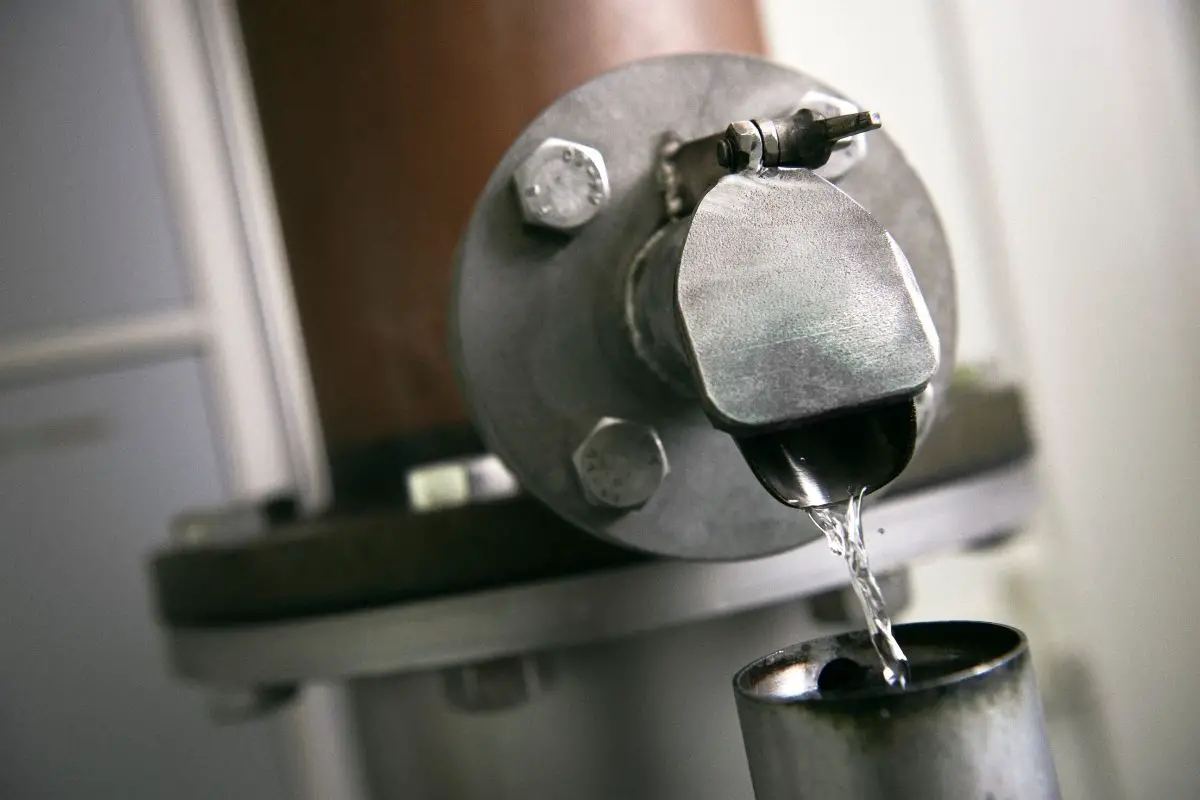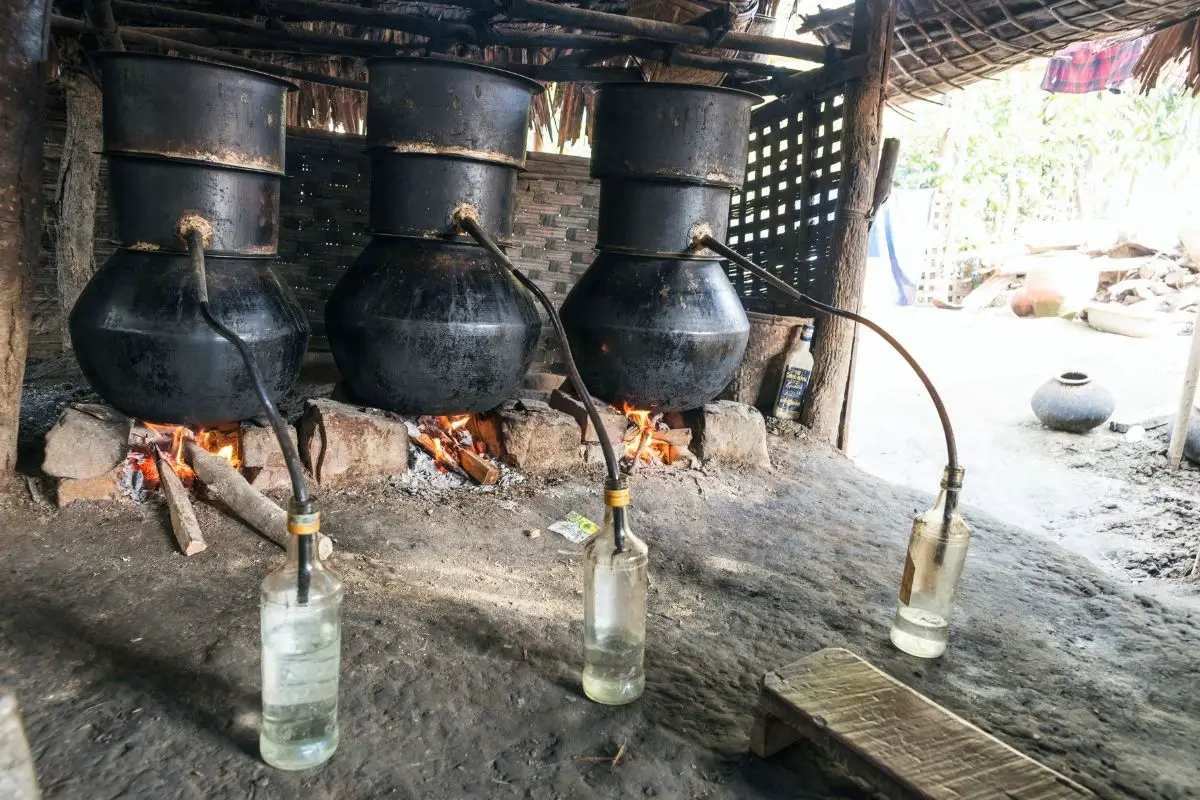Distilling is the process of heating liquids until they turn into a gas and condensing them back into a liquid. This process creates an alcoholic beverage or perfume.
Heating a liquid with fire makes the liquid evaporate and become a gas. Holding something cold over the warm vapors causes them to condense back into a liquid.

Distilling water requires heat. In order to make alcohol, you need to boil water. You also need an object that can hold the steam (like a pot or pan).
When you put the water into the pot or pan, the steam rises up and condenses back down onto the surface of the liquid. This is called boiling.
But, this is just the basics. So, how do you distill alcohol? Keep on reading to find out!
How To Distill Alcohol
There are no naked flames, electric heaters, running water, or electrical contacts. There are no dangerous chemicals and no fires. A fan blows away any alcohol fumes.
Alcohol is made by distilling fermented mash or wine. The alcohol content is usually expressed as proof (abbreviated ‘p.’) or percentage (e.g., 80% ABV). Proof refers to how much alcohol there is per volume of liquid. A higher number means more alcohol.
For example, 40% ABV means that there is 4 parts alcohol to every 1 part of the original beverage. This is also known as ‘potency’. The percentage refers to the amount of alcohol in relation to 100%.
For example, 80% ABV means that there is 8 parts alcohol to every 10 parts of the original beverage.
Step Equipment
So what equipment is needed to distill alcohol? Well…
Sodium hydroxides (pearl not flakes) are used to measure acidity and alkalinity in water.
Sodium bicarbonates are used to neutralize acids.
Alcohol meters are used to measure alcohol content.
Hydrometers are used to measure density.
Conductivity meters are used to measure salinity.
Gloves and goggles are needed when handling chemicals.
A scale is used to weigh chemicals.
Copper pipes are used to make tubing.
Glass storage bottles are used to store chemicals.
A Brita filter is used to remove impurities from tap water.
When you have all this equipment at the ready, then it is time to begin distilling your alcohol. But remember…
When heated, sodium hydroxide ignites into an extremely hot flame. This chemical should never be left unattended or near anything flammable. Gloves and goggles must be worn while handling this chemical.
You should ensure that there is plenty of ventilation in the room. Use an electronic alcohol vapor detector if possible. Ensure that you are competent in handling chemicals and machines.
Alcohol distillation requires a lot of technical knowledge and equipment. Don’t attempt this without supervision. You also shouldn’t dive into distilling your own alcohol without doing ample research.
Aging
Spirits need to be aged for specific periods of time before being bottled. Some spirits need to be aged in certain containers.
Distilled spirits are usually diluted before bottling. Water is added to make the drink easier to consume. Bourbon must be aged in new oak barrels. Spirits such as whiskey, rum, vodka, etc., have very specific requirements.
Is Home Brewing Legal?

Distilling your own alcohol is legal in most places. However, it is also illegal in some places. You should check your local laws before you start making your own alcohol.
Yeast strains need to be purchased from a reputable source. Wild yeasts could cause problems when distilled.
How To Distill Alcohol
Home brewing requires safety precautions. You should wear gloves and goggles when you measure the pH level. If your brew is too acidic, you need to use more pearls of sodium hydrate to raise the pH level.
If the brew is too alkaline, you may want to add some citric or lactic acids to lower the pH level.
Once you have done this, you should begin slowly adding the segments of copper pipe into your still boiler. This allows any leftover acid to react with the copper, allowing copper sulfates to remain in the boiler, rather than evaporating.
Add the brew to the boiler. No higher than the line gouge on the inside. Place the 50ml measuring cylinder under the output spout. Turn on the still, ensuring enough ambient ventilation.
Collect the first 30 ml of distillate and throw it away because it will be rich in Methanol, which is poisonous. This is called the head cut and can be adjusted for various desired flavors. Some brews may require a greater head cut to remove other chemicals, such as aldehydic, ketonic, esoteric, etc.
Copper soap is usually clear or white. It may contain some suspended particles. When you distill it, the particles will settle out and the liquid will become clearer.
The pH of your copper soap should be around 6.0. You should also check the conductivity of your copper soap. It should be less than 10 ppm.
If the copper soap contains impurities, such as sulfuric acid or heavy metals, then these impurities will cause the pH to drop and the conductivity to rise.
A Britvic water filter removes chemicals from the alcohol. As we have just said, a number of different chemicals are used in the distillation process, and not all of these chemicals are safe for consumption.
So, by using a Britvic water filter, you will be able to make your alcohol safe to drink.
Alcohol products are made by distilling the fermented mash of fruit or vegetables. This process removes most of the water content and concentrates the sugars into a liquid form called ‘alcohol’.
Alcohols are then stored in barrels, bottles, or casks. Wine, beer, and spirits are all types of alcoholic beverages.
Activated carbon can be used as an effective filter to remove chemical compounds from water. Experimentation is key when using activated carbon. We should also try drinking the product before trying to taste it.
We should focus on the flavor first, and then the aroma. There may be some subtle flavors lingering in the background that we need to enhance. Tasting before you complete the distillation process ensures that your alcohol will taste exactly as you want it to.
Conclusion
Distillation is used to make alcoholic beverages such as wine, beer, vodka, whiskey, brandy, etc. When distilling alcohol, the whole mash is put into the still.
It is important to avoid filtering the mash before distilling because it would result in loss of flavor and aroma.
A still is a vessel that has a heating element inside. Alcohol evaporates from the mash and collects in the condenser. After the alcohol has been condensed, it is collected in bottles or other containers.
- Vevor Still Instructions - June 12, 2023
- Best Proofing Parrots For Home Distilling - February 1, 2023
- What Is A Porter Beer? - June 12, 2022
